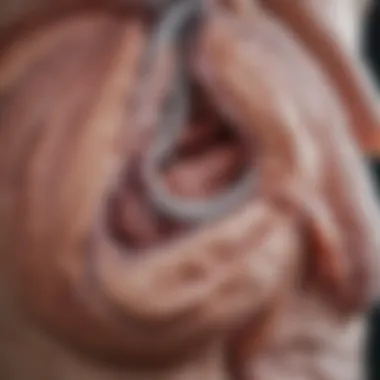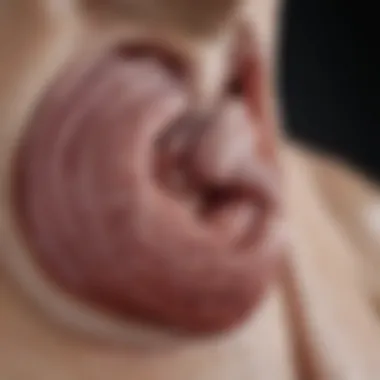Understanding Lung Hernias: Insights and Advances


Intro
Lung hernias represent a complex medical condition that is not widely discussed in literature. Understanding the mechanisms behind lung hernias requires delving into various anatomical and physiological factors. This condition can manifest due to several reasons, including congenital defects, trauma, or surgery. It poses significant challenges in diagnosis and management, highlighting the need for a comprehensive awareness among medical professionals.
The exploration of lung hernias will provide insight into their pathology, emphasizing the importance of accurate diagnosis and tailored treatment options. As this topic has garnered more attention in recent years, ongoing research is crucial for developing innovative approaches to tackle this rare condition.
By shedding light on lung hernias, we aim to equip students, educators, researchers, and medical professionals with the necessary knowledge to understand this intricate phenomenon and its implications in clinical settings.
Understanding Lung Hernias
Understanding lung hernias is vital for comprehending the broader implications of respiratory health issues. This section lays a foundation for interpreting the nuances of lung hernias, their definitions, and the anatomical context in which they occur. By addressing these underlying factors, the article aims to equip readers with a comprehensive framework that aids in recognizing potential complications, treatment pathways, and advances in research.
Defining Lung Hernia
A lung hernia refers to a condition where lung tissue protrudes through a defect in the surrounding structures, typically involving the chest wall or diaphragm. This condition can manifest in different forms depending on the causes and anatomical changes within the body. A clear understanding of this definition helps shape a considerable discussion on its implications for lung function and overall health. Given that lung hernias are relatively rare, this clarity is beneficial for both diagnosis and treatment options available to affected individuals.
Anatomy of the Lung
The anatomy of the lung is crucial to grasping the complexities of lung hernias. A deeper insight into the structure, function, and neighboring features provides context around how hernias can develop and impact patients.
Structure of Lung Tissues
The lung is composed of various tissues that work cohesively to facilitate respiration. These include the alveolar tissue, which is integral for gas exchange, and the bronchi, which help direct airflow. The distinctive layout of lung tissues enables efficient functioning. A unique feature of lung tissue is its extensive surface area, resulting from numerous alveoli that increase the efficiency of oxygen absorption. However, this fragility also makes the tissues susceptible to structural defects, leading to conditions such as lung hernias.
Key Functions of the Lung
Lungs have several critical functions, most notably gas exchange, where oxygen is taken in and carbon dioxide is expelled. This process is vital for maintaining homeostasis in the body. The primary characteristic of lung functions benefits cellular metabolism by ensuring that oxygen-rich blood is circulated throughout the body. Furthermore, the lung’s ability to adapt to varying demands—such as increased respiratory rates during exercise—illustrates its resilience and importance in daily life. Awareness of these functions can enlighten discussions about lung hernias, as disruptions can severely impact these essential processes.
Surrounding Anatomical Features
The lungs are not isolated; they interact closely with surrounding anatomical structures, such as the diaphragm and rib cage. The diaphragm plays a critical role in the mechanics of breathing, while the rib cage protects lung tissues. An essential aspect of surrounding features is the pleura, which envelops the lungs and aids in facilitating smooth movement during respiration. Any compromise in these structures, whether through injury or a congenital anomaly, can increase the risk of developing lung hernias. Recognizing these relationships is fundamental in understanding the potential for herniation and the resultant consequences on respiratory function.
Types of Lung Hernias
The classification of lung hernias is crucial for understanding their implications. The types can be broadly divided into congenital and acquired categories. Each type carries its own set of characteristics, causes, and potential consequences on lung function. Understanding these distinctions can greatly aid in diagnosis and treatment, ultimately enhancing patient outcomes.
Congenital Lung Hernias
Congenital lung hernias are structural anomalies that occur during fetal development. These anomalies can lead to significant thoracic issues if not addressed.
Types of Congenital Anomalies
Congenital lung hernias may present in various forms. The most common types include bronchopulmonary dysplasia and congenital diaphragmatic hernia.
- Bronchopulmonary dysplasia is characterized by abnormalities in lung tissue development, often leading to a compromised airway and reduced gas exchange capacity.
- Congenital diaphragmatic hernia involves a defect in the diaphragm, allowing abdominal contents to move into the thoracic cavity, impacting lung volume and function.
These anomalies contribute significantly to understanding lung hernias. Their presence underscores the need for early intervention and constant monitoring during childhood, emphasizing the requirement for a tailored treatment approach. One key characteristic of congenital anomalies is their typically first detection during prenatal scans, making early surgical correction a possible and desirable choice. However, one drawback is the unpredictable post-surgical recovery, which can vary greatly from child to child.
Mechanisms of Development
The mechanisms underlying the development of congenital lung hernias stem from various genetic and environmental factors.
- Genetic mutations can disrupt normal growth patterns, leading to anatomical abnormalities.
- Maternal factors, such as exposure to teratogens, may also play a crucial role during critical periods of development.
A significant aspect of this mechanism is the timing of exposure and genetic predisposition. The unique feature of these mechanisms is their multifactorial nature, making complete prevention challenging. However, understanding these mechanisms allows for heightened awareness and potential screening during pregnancy.
Acquired Lung Hernias
Acquired lung hernias arise due to external forces or pathological conditions that develop over time. These hernias can result from trauma, surgical incisions, or pressure-related changes in the thoracic cavity.


Causes of Acquired Conditions
Various factors contribute to the formation of acquired lung hernias. Common causes include:
- Traumatic injury to the thoracic region, leading to fissures or ruptures.
- Surgical interventions that may inadvertently weaken the protective structures around the lungs, leading to herniation.
- Increased intra-abdominal pressure due to conditions like obesity or chronic cough, which can push lung tissue through weakened areas.
These causes are important since they assist healthcare professionals in identifying at-risk patients, particularly in surgical settings. Understanding how each factor plays into the overall risk profile for lung hernias is beneficial when designing preventative strategies and assessing patient history.
Risk Factors and Prevalence
Risk factors for acquired lung hernias differ widely and can include both lifestyle and medical history.
- Obesity is a notable risk factor, as excess weight places additional pressure on the abdominal organs.
- Chronic respiratory diseases, such as COPD, can cause persistent pressure fluctuations that may predispose individuals to hernia formation.
The prevalence of acquired lung hernias is increasing, particularly in populations with higher rates of obesity and respiratory conditions. A key characteristic of this trend is the correlation with lifestyle changes and demographic shifts. This knowledge highlights the necessity for vigilant monitoring in certain patient demographics, ensuring timely diagnosis and intervention to mitigate complications.
Pathophysiology of Lung Hernias
Understanding the pathophysiology of lung hernias is crucial for various reasons. First, it provides insight into how these conditions develop and affect lung function. By grasping the underlying mechanisms, clinicians can identify and classify different types of hernias effectively. This knowledge aids in choosing the proper diagnostic methods and management strategies. It also adds to the body of research that enhances our understanding of similar conditions, potentially improving patient outcomes.
Mechanisms of Herniation
Lung hernias occur when lung tissue protrudes through a defect in the chest wall. This can happen due to increases in intra-thoracic pressure or weaknesses in the surrounding structures. Common mechanisms include:
- Congenital factors: Some individuals are born with structural weaknesses in their chest wall.
- Trauma: Physical injuries can cause defects that allow lung tissue to herniate.
- Surgical complications: Previous surgeries may leave weaknesses that can lead to hernias.
These mechanisms often combine, leading to varying degrees of herniation. The severity of herniation will affect not only anatomical structure but also functions such as gas exchange.
Physiological Impact on Lung Function
The physiological impact of lung hernias on lung function is significant. There are two primary areas of concern: gas exchange and respiratory mechanics.
Effect on Gas Exchange
The effect on gas exchange is crucial for understanding how a hernia can compromise health. Lung hernias can reduce the surface area available for gas exchange. This can lead to reduced oxygen uptake and carbon dioxide elimination. Patients with lung hernias may experience symptoms such as dyspnea or fatigue because of hypoxemia. Furthermore, the condition can aggravate existing lung conditions like chronic obstructive pulmonary disease (COPD).
Research shows that effective treatment of lung hernias can restore adequate pulmonary function, highlighting the importance of timely intervention.
Influence on Respiratory Mechanics
The influence on respiratory mechanics is another important consideration. Herniation can alter how the lungs expand and contract. This affects overall respiratory dynamics, making each breath less efficient. Key characteristics of these mechanical changes include:
- Decreased lung compliance: This may result in difficulty breathing, especially during exertion.
- Altered tidal volume: Patients might have to adapt by using accessory muscles, leading to fatigue.
Recognizing these changes allows for improved management and interventions tailored to the individual needs of patients. During clinical assessments, understanding both gas exchange and mechanical impacts can lead to better treatment outcomes and refined therapeutic strategies.
Clinical Presentation
The clinical presentation of lung hernias is essential in understanding the implications of this condition. Recognizing the signs and symptoms allows for timely diagnosis and treatment, minimizing complications. Lung hernias often present unique challenges. Early identification is critical to manage the condition effectively and tailor interventions to patient needs.
Symptoms of Lung Hernia
Common Signs Noted in Patients
Common signs associated with lung hernias include respiratory distress, chest pain, and coughing. Patients may also experience a noticeable bulge or deformity in the chest wall, which can be alarming. This feature is important because it leads to the initial examination by healthcare providers. Understanding these common signs helps clinicians to focus on the right diagnostic pathways early in the process. The clear symptoms allow practitioners to make informed decisions, potentially accelerating the course of treatment.
- Respiratory distress can manifest as shortness of breath, especially during physical activity. It may indicate compromised lung function due to the hernia's impact on surrounding tissues.
- Chest pain might vary in intensity and could be mistaken for heart-related issues. However, it often relates directly to the hernia's influence on the thoracic cavity.
- Visible bulge increases the likelihood of referral for imaging studies to clarify the condition's nature.
Variability in Symptoms by Type
The variability in symptoms by type of lung hernia is noteworthy and contributes to complexity in diagnosis. Different types of lung hernias such as congenital and acquired ones lead to various clinical manifestations. This underscores the importance of a thorough patient history and examination to identify the type of hernia present.


Each type has distinct symptom profiles. For example, congenital lung hernias may present sooner in life, while acquired ones can emerge later, often linked to trauma or surgery. Recognizing these patterns assists in effective stratification of care. The variation can also challenge healthcare practitioners, making thorough knowledge of each subtype beneficial in practice.
Differential Diagnosis
Conditions Mimicking Lung Hernia
Several conditions can mimic lung hernia, which can complicate diagnosis. These include pulmonary cysts, chest wall deformities, and pleural effusions. This similarity in presentations necessitates precision in distinguishing between them and lung hernias. Accurate differentiation is vital in determining the correct clinical approach and avoiding mismanagement of the patient’s condition.
The overlapping characteristics can confuse a clinician, further emphasizing the need for comprehensive imaging and patient history assessment.
- For instance, both pleural effusions and lung hernias can cause chest pain and dyspnea, but their underlying mechanisms and treatments differ significantly.
Diagnostic Challenges
Diagnostic challenges arise when evaluating lung hernias due to their rarity and similarity to other conditions. Imaging techniques such as X-rays, CT scans, and sometimes MRI play crucial roles in getting accurate results. However, the interpretation of imaging can be subjective. Knowledge of the condition is limited among some practitioners; therefore, awareness and training are necessary to improve diagnostic accuracy.
Additionally, lung hernias might not always present in a straightforward manner. Favorable outcomes rely significantly on the clinicians' awareness of these diagnostic challenges, pushing for continuous education and awareness among medical professionals regarding lung hernia.
"An accurate diagnosis of lung hernia hinges on a nuanced understanding of its clinical presentation and the conditions that may mimic it."
In summary, the clinical presentation of lung hernias, combined with the variability of symptoms and diagnostic challenges, highlights the complexity surrounding this medical condition. As research advances and awareness grows, the ability to recognize and treat lung hernias effectively will continue to improve.
Diagnostic Methods
Diagnosing lung hernias presents specific challenges due to the rarity and complexity of the condition. Accurate diagnostic methods are crucial for effective management and treatment. A combination of imaging techniques and histopathological examinations can provide comprehensive insights into the presence, extent, and implications of lung hernias. These methods also help tailor treatment strategies and improve patient outcomes. Let's explore the diagnostic approaches in detail.
Imaging Techniques
Role of X-ray
X-rays serve as a frontline diagnostic tool for assessing lung conditions, including lung hernias. They are quick and accessible, making them a popular choice in initial evaluations. The primary contribution of X-rays lies in their ability to reveal structural abnormalities in the chest region. A notable characteristic of X-rays is their capacity to provide immediate visual information, allowing for rapid assessment of potential herniation.
The unique feature of X-rays in diagnosing lung hernias is their ability to identify displacement of lung structures. This helps physicians determine if a hernia is present. However, while X-rays are beneficial for initial assessments, they have limitations. Their resolution may not be sufficient to evaluate the full extent of the hernia or to visualize surrounding anatomical features accurately. Therefore, further diagnostic methods may be warranted for a comprehensive understanding of the condition.
CT and MRI Applications
Computed Tomography (CT) and Magnetic Resonance Imaging (MRI) are advanced imaging modalities that play a significant role in diagnosing lung hernias. These techniques offer detailed cross-sectional images of the lung, facilitating a more thorough examination of structures and surrounding tissues. The key characteristic of CT scans is their ability to provide high-resolution images, which enhance the detection of subtle anatomical changes that may indicate herniation.
Moreover, MRI is particularly advantageous in cases where patient exposure to radiation is a concern. The unique feature of MRI is its exceptional capability to visualize soft tissues, thus offering additional detail about the lung's anatomic design and any associated pathology. However, these methods can be more time-consuming and expensive compared to X-rays, which may limit their availability in some clinical settings.
Histopathological Examination
Histopathological examination is an essential diagnostic method in identifying lung hernias with underlying tissue abnormalities. This technique involves analyzing tissue samples collected during diagnostic procedures. It offers invaluable insights into the cellular makeup of lung tissues and any pathological alterations present.
The importance of histopathological examination lies in its ability to differentiate between various types of hernias and associated complications. By examining tissue samples, clinicians can identify the presence of any malignancies or inflammatory processes, which may influence treatment decisions. Although histopathological examination is not the primary diagnostic tool, it serves as a valuable complement to imaging methods, helping to confirm diagnoses and provide more detailed information for individualized patient care.
Management Strategies
Understanding the management strategies for lung hernias is crucial for effective treatment and patient care. This section delves into the various approaches that can be employed to address this rare condition, highlighting the importance of both surgical and non-surgical options. The objective is to provide a comprehensive view of how these strategies contribute to the overall management of lung hernias, emphasizing the necessity of tailored treatment plans depending on individual patient circumstances.
Surgical Interventions
Surgical intervention often becomes necessary for patients with lung hernias. The decision for surgery is based on several factors, including the severity of symptoms and the risk of complications.
Indications for Surgery
The main indication for surgery is the presence of significant symptoms impacting patient’s quality of life. This can manifest as persistent pain, respiratory distress, or complications like strangulation of lung tissue. The surgical approach helps to alleviate these symptoms effectively. What makes this choice popular is the potential for complete recovery.
There is a unique characteristic of surgical indications: they often depend on both clinical presentation and imaging findings. For example, the presence of recurrent lung collapses or a sizeable herniation may warrant urgent surgical action. However, surgery also carries risks, such as infection or anesthesia complications. These factors must be weighed carefully.
Surgical Techniques Employed


When surgery is necessary, various techniques can be used, ranging from open surgery to minimally invasive methods like video-assisted thoracoscopic surgery (VATS). Minimally invasive techniques are becoming increasingly favored due to their advantages, such as reduced recovery time and smaller incisions, leading to less postoperative pain.
Each surgical technique has unique features that can influence outcomes. For instance, VATS allows for precise visualization and manipulation, which can enhance surgical effectiveness. Nonetheless, these techniques also require skilled surgeons and may not be available everywhere, presenting a potential disadvantage for some patients.
Non-surgical Approaches
Not all patients with lung hernias require surgery. In many situations, non-surgical approaches can be effective in managing symptoms and monitoring the condition.
Supportive Care
Supportive care emphasizes the management of symptoms rather than the hernia itself. This can include pain management, respiratory therapy, and lifestyle adjustments. The benefit of supportive care is that it provides immediate relief without the risks associated with surgery.
However, supportive care is not a definitive solution. Patients may need ongoing assessment to evaluate if their condition progresses to a point where surgery becomes necessary. Therefore, while it provides temporary relief, there is a unique challenge in ensuring complete management of the hernia.
Monitoring and Follow-up
Monitoring and follow-up are essential components of non-surgical management. Regular evaluations can help track the progression of the hernia and anticipate any changes in the patient’s condition. The characteristic advantage of a structured follow-up plan is that it allows for proactive intervention if surgical options become necessary.
This monitoring is typically done through imaging and clinical assessments. Although generally low-risk, invasive procedures might still be required periodically. Thus, a balance between non-invasive monitoring and timely surgical intervention is crucial for optimal patient outcomes.
"The key to managing lung hernias lies in understanding both surgical and non-surgical strategies. Tailoring the approach to each patient’s specific needs is critical."
Emerging Research and Findings
The study of lung hernias is evolving. New research offers insights that redefine our understanding of this rare condition. Understanding emerging research is crucial for enhancing diagnostic accuracy and treatment effectiveness.
Recent Studies on Lung Hernias
Current Discoveries
Recent studies have focused on genetic predispositions and morphological changes associated with lung hernias. This is crucial as it identifies factors that contribute to the condition's development. Current discoveries shed light on atypical presentations and variations of lung hernias that were previously overlooked. This may help clinicians make informed decisions based on these findings, ultimately improving patient outcomes. Key characteristics of these discoveries include their focus on personalized medicine approaches that cater to individual patient profiles. This consideration is beneficial as it paves the way for more effective treatment plans tailored to specific needs, rather than a one-size-fits-all approach. However, navigating these new findings may require additional training and resources for healthcare providers.
Implications for Treatment
The discoveries also underscore significant implications for treatment options available for lung hernias. One key aspect is the enhancement of minimally invasive surgical techniques supported by new imaging technologies. These advancements offer more precise targeting and reduced recovery times. Minimally invasive approaches represent a benefit for patients, minimizing scarring and postoperative complications. An important feature of this evolution is the integration of multidisciplinary care involving respiratory therapists, surgeons, and radiologists. Such collaboration is vital to achieve comprehensive treatment. Yet, the adjustment to these protocols and maintenance of communication among specialties can present challenges.
Future Research Directions
Invitations for Clinical Trials
The need for more clinical trials is overwhelming. Current research indicates gaps in understanding the long-term outcomes of various treatments for lung hernias. As such, there are invitations for clinical trials focused on exploring different procedures and rehabilitation strategies. Key characteristics of these trials include their potential to yield data that can refine classification systems for lung hernias. This may create more accurate predictive models for treatment outcomes, making it a highly beneficial proposition. Engaging in these trials can enhance knowledge and improve patient care. However, obtaining adequate funding and participant recruitment remains a significant hurdle to address.
Potential for Better Outcomes
The exploration of innovative treatment protocols presents a potential for better outcomes in lung hernia management. Recent advances suggest that combining surgical methods with enhanced rehabilitative care mechanisms could facilitate recovery and functionality. The distinctive feature of these potential strategies is their focus on patient-centric approaches, allowing individuals to return to their normal activities more quickly. Improving quality of life is a primary objective, and this focus makes it an attractive area for future research. Nevertheless, more systematic studies are required to evaluate the effectiveness and practicality of these combinations in real-world settings.
"Emerging research in lung hernias holds promise for redefining treatment approaches and improving patient outcomes."
Through these emerging findings, a clearer understanding of lung hernias will ultimately benefit both clinical practice and patient experience. Continued investigation is essential for refining existing knowledge and developing innovative strategies in this complex field.
Culmination
The conclusion serves as a pivotal segment in the article, encapsulating the breadth of information presented about lung hernias while emphasizing the significance of ongoing research. By synthesizing the core findings, it reinforces the reader's understanding of this rare yet impactful medical condition.
Summary of Key Points
In summary, the intricacies of lung hernias have been thoroughly explored through various lenses, including:
- Defining Lung Hernia: Introduction to lung hernias, emphasizing their rarity and complexity.
- Types: Clarity on congenital and acquired types, along with their developmental mechanisms.
- Pathophysiology: Detailed mechanisms of herniation and the physiological impacts, highlighting effects on gas exchange and respiratory mechanics.
- Clinical Presentation: Recognition of symptoms that vary by type and the diagnostic challenges that arise due to similarities with other conditions.
- Diagnostic Methods: Overview of imaging techniques, especially the role of X-ray, CT, and MRI.
- Management Strategies: Distinction between surgical and non-surgical approaches, including indications and supportive care strategies.
- Emerging Research: Insights into recent studies and the avenues for future research that may inform better treatment outcomes.
The Importance of Continued Research
The urgency for continued research into lung hernias cannot be overstated. While the current understanding provides a strong foundation, the complexities of this condition present numerous unanswered questions. By fostering research initiatives, professionals can delve deeper into:
- Identification of Underlying Mechanisms: Better understanding the anatomical and physiological changes that lead to lung hernias can enlighten preventive strategies.
- Improved Diagnostic Methods: Innovations in imaging and analysis may enhance the accuracy and timeliness of diagnoses, reducing the burden of misdiagnosis.
- Effective Treatment Protocols: Exploring new treatment modalities through clinical trials can offer alternative methods for managing lung hernias, potentially leading to enhanced patient outcomes.
Ongoing discourse and studies in this field are vital for advancing knowledge and improving clinical practices. As we stand at the nexus of research and practice, the commitment to exploring lung hernias furthers our understanding, ultimately benefitting those affected by this rare condition.



